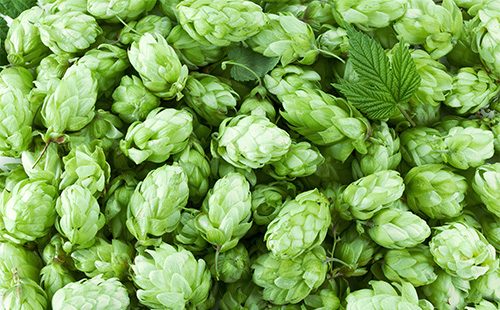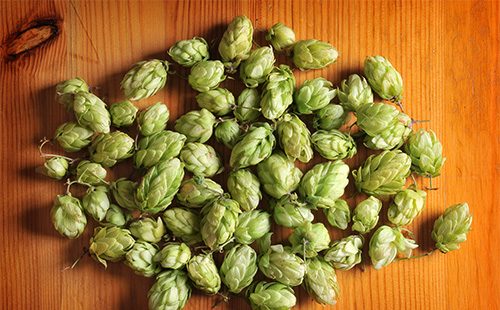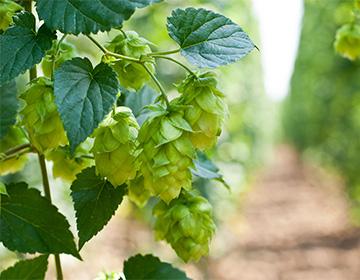The content of the article
Compared to other herbs, hops look very unusual - this is a fast-growing vine, the length of which can reach 14 m. The daily growth of branches is 20 cm. Therefore, the culture can be called a champion in terms of development speed. Medicinal raw materials - cones - are female flowers of a plant in which seeds develop. Some herbalists call them fertility, although it is more correct to use the term "inflorescences."
Botanical characteristics of hops
The representative of the Konoplev family, common hop, is found in regions with a warm and temperate climate. Prefers moist soils rich in nutrients and humus. Often settles near rivers and streams, braiding trees - willow, alder. Widely distributed in Ukraine and Belarus. It is found almost everywhere in Russia, except for the Northern regions. In the European part, in the west and east of Siberia, as well as in the Far Eastern region, it grows, forming dense thickets.
Dioecious plant. Female and male flowers are located on different individuals. It is planted in parks and on private estates as an ornamental plant forming hedges. For medicinal purposes, only female individuals are grown. You can recognize the culture by morphological characteristics.
- Underground part. It is represented by a long fleshy rhizome. Many skeleton-like roots depart from it, because of which the plant absorbs moisture from an impressive area of soil. Their surface is light brown, the core is light, almost white. Hops penetrate into the soil 3 m or more. The root of the plant lives for two decades.
- The stalks. Leafy shoots reach an average of 6 m, but under favorable conditions can be much longer. Thickly covered with hooked spikes. Develop in the warm season and die in the winter. They can creep on the earth until they find a suitable elevation for development.
- Leaves. The leaves on the stems are opposite, attached with long stalks. Simple leaves are located at the end of the vines, and complex ones along the entire length. Consist of three to five blades. The edge of the leaf plate is fine-toothed. The surface is rough. Color - deep green above, gray-green - below. There are glands on the underside.
- Flowers. Female hop flowers are tightly collected in a spike-shaped inflorescence resembling a cone of light green color. Male - represented by small panicles, on which there are no petals. Flowering plants occur in July-August.
- Fruit. The seeds are enclosed in flattened brown nuts. Ripen in September. Each nut contains only one seed.
Harvesting raw materials
Procurement begins in August. Green inflorescences are unsuitable for medicinal use. The integrity of the raw material also indicates its quality. The bumps scattering in the hands are already overripe.
- Collection. Inflorescences are torn off with hands or cut with scissors. Picking with or without peduncles is allowed. Hops are transported without tamping, loosely folded into large baskets or cardboard boxes.
- Training. The collected inflorescences are sorted out, removing the immature ones. There should not be brown cones. Ideal is green-yellow raw materials.
- Drying. Cones are laid out in a thin layer on a pallet. It is placed under a canopy or in a well-ventilated area. Warm attics are great. The complete crackling of the inflorescences is indicated by the characteristic crack of the central vein, which is heard when the cone is bent.
- Storage. Fully dried flowers are stacked in wooden or cardboard containers. Keep in a dark, dry place. Hops are characterized by the accumulation of aromatic substances during storage.
Composition
Cones are valued in medicine and cooking for the content of bitterness. The latter are represented by various types of natural resinous compounds: organic acids and resins. The most valuable of them is lupulin, which has a calming effect. This substance is toxic in itself, however, hop preparation is carried out precisely because of it. When exposed to high temperatures, lupulin decomposes into an alkaloid residue - humulin. This compound exhibits antimicrobial activity, stimulates the appetite and the functioning of the glands. Lupulon, formed during the breakdown of lupulin, is considered a natural preservative, inhibits the development of pathogenic microflora.
Other important substances in hop inflorescences:
- essential oil - stimulates secretion, eliminates microbes, has a sedative effect;
- polyphenolic substances - give raw materials diuretic, antiarrhythmic, antihypertensive activity;
- flavonoids - stimulate secretion, strengthen blood vessels, eliminate free radicals, purify blood;
- coumarins - regulate coagulability, stimulate metabolism, have anti-inflammatory properties;
- tannins - differ in anti-inflammatory, hemostatic, wound healing properties;
- choline- regulates lipid metabolism, improves metabolism, optimizes the functioning of liver and gall bladder cells;
- phytoestrogens- eliminate the symptoms of menopause, regulate the menstrual cycle, violated on the background of hormonal disorders or stresses.
The properties
Sedation is the main thing, because of which the plant is valued in folk and official medicine. Even inhaling the aroma of cones has a beneficial effect on the functioning of the nervous system, normalizes the ratio of the processes of excitation and inhibition in the brain. Along with a sedative effect, an antiarrhythmic effect and a decrease in blood pressure are noted.
Hop bitterness stimulates the digestive tract:
- increase the secretion of digestive juices;
- start motility;
- damage is healed;
- improve metabolism;
- increase appetite;
- eliminate rotting processes;
- treat flatulence;
- increase the acidity of gastric juice.
The antibacterial and antiallergic effects of the plant are highly appreciated.This is relevant in the treatment of skin diseases of an infectious-inflammatory nature. The plant alleviates the symptoms of allergies, promotes accelerated healing of injuries and improves blood circulation to the surface tissues.

Diseases for which it helps
The plant stabilizes the nervous system, so they treat a whole range of neurogenic disorders:
- hysteria;
- neurasthenia;
- nervousness;
- ICP;
- increased sexual activity;
- pathological emissions in adolescents;
- insomnia
- neuralgia;
- dizziness;
- cardioneurosis;
- motion sickness;
- bed-wetting.
Digestive organs
With the help of cones, hyposecretory pathologies of the digestive tract are eliminated. Due to its powerful antimicrobial effect, the culture is used in the treatment of hepatitis, cholecystitis, gastroenterocolitis of an infectious nature or provoked by digestive disorders. The benefits of the plant for diabetes, obesity, and other metabolic disorders are noted. Use as a stimulant for weight loss.
urinary system
Hops are recommended as a mild diuretic with antibacterial properties in the treatment of cystitis, infectious and inflammatory lesions of the kidneys, bladder and urinary ducts. The plant is also useful for men - it facilitates the passage of urine and relieves inflammation with prostatitis.
Women Health
As a plant source of estrogen, culture is used for:
- lack of estrogen;
- lack of menstruation;
- cycle failures;
- hyperlactation;
- the need to suppress lactation.
Cosmetic defects
Due to the content of resins, organic acids and flavonoids, the plant has a positive effect on the regeneration processes, improves blood circulation and strengthens blood vessels. It is used in cosmetology to treat rosacea, normalize oily skin, eliminate rashes, rejuvenate and renew the epidermis. Cosmetics are enriched with oil from cones, they are used in their pure form as a moisturizing and healing agent.
Extracts from the plant are rubbed into the roots of the hair during baldness. Rinse the strands along the entire length to improve their general condition. Means containing hops are recommended for use with oily scalp, seborrhea, dandruff.
Prescription Drugs
For the preparation of medicines, raw materials can be purchased at a pharmacy or prepared on their own. Of cones make water and alcohol extracts, ointments.
For the digestive tract
Features The infusion is used to improve the secretory function of the gastrointestinal glands, as well as in the treatment of infectious and inflammatory diseases of the kidneys and urinary tract.
Preparation and use
- Two tablespoons of raw materials are poured into a thermos.
- Pour the cones with a glass of boiling water.
- Tightly closing the vessel, leave the mixture to infuse for four hours.
- After filtering, the drug is taken in half a glass four times a day half an hour before meals.
For sleep
Features Tincture is used to treat insomnia, neurosis, improve sleep quality.
Preparation and use
- A quarter glass container is filled with dry cones.
- Pour raw materials with vodka, filling the tank to the top.
- The drug is insisted for a week, after which it is filtered.
- Drink five drops twice for knocking, mixed with a tablespoon of water.
For joints
Features Ointment is used to eliminate joint pain, accelerate bone fusion, from inflammation of muscles and tendons.
Preparation and use
- Mix a tablespoon of fat base and a tablespoon of chopped cones.
- The mixture is placed in a water bath. After melting, the stems are languished for half an hour.
- The ointment is poured into a storage container and put in the refrigerator.
- Rubbed into painful places in circular motions twice a day.

For skin and hair
Features A decoction improves hair growth and skin condition. They are washed with wounds and injuries for speedy healing.
Preparation and use
- Four tablespoons of cones pour a glass of boiling water.
- Heated for three minutes over low heat, and then covered with a lid.
- Insist four hours, filter.
- Rubbed into the roots an hour before shampooing or rinsing immediately after washing.
With abuse of medication from the cones, side effects are likely: headaches in the stomach, heartburn, nausea, and vomiting.

